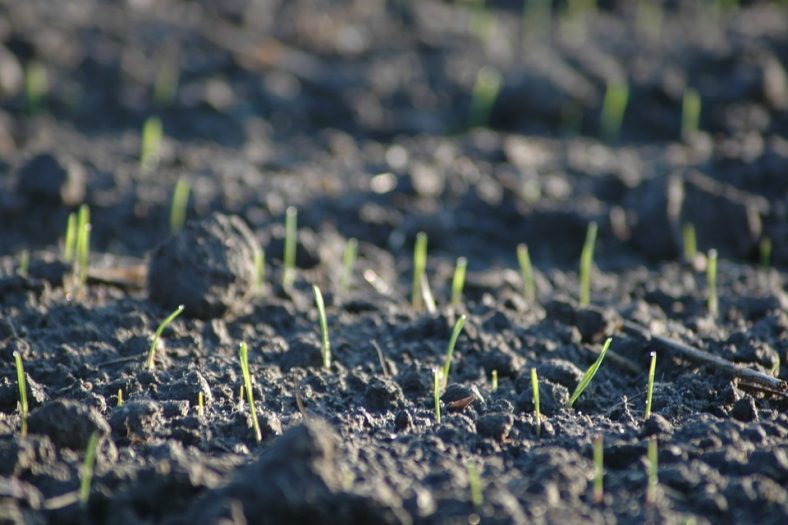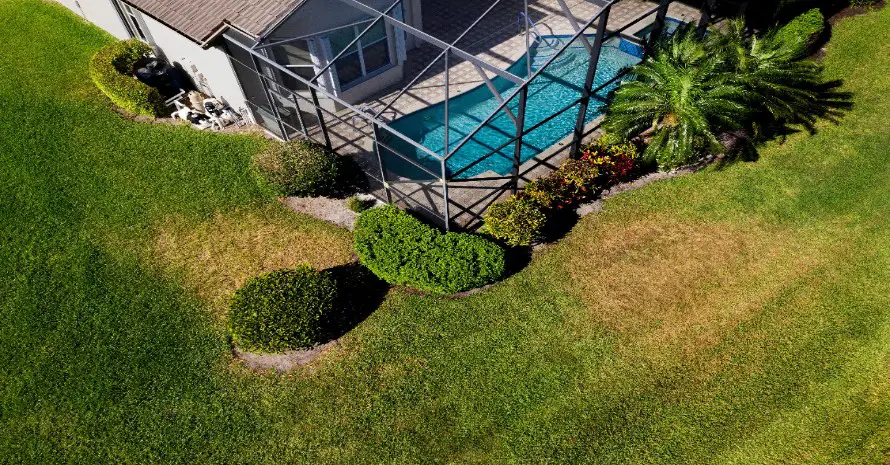A lot of factors influence grass growing time. Depending on the area, type of grass, soil type (pH), it may take from 5 up to 30 days for grass to grow. Other factors to consider are the amount of sunlight, ground temperature, and even moisture.
My grass actually grew for 21 days. It is important to note that a green lawn usually takes more time to look finished. Therefore, dealing with it, you have to be more attentive and patient. You also need experience and professional advice from somebody in this field who has successfully done it. So go through the article to get more details on how to cope with this fascinating process!
How Long Does It Take for Grass Seed to Grow?
In case you would like to investigate how long does it take for grass to grow, prepare yourself for a fascinating journey ending with a complete guide on the grass gardening process. Supposedly, you are interested in getting quick results and wondering “how long does grass seed take to grow fully?”
For this reason, I’ve created a table to help you further. Here, you will get to know about the best soil type for each grass seed and the most appropriate season for planting. Additionally, I have included the information regarding average germination time for grass seed. Examine the table below to get every essential piece you may need.
| Grass seed | Germination time | Season | Soil type (pH) |
| Bahia | 7 – 21 days | Warm | 5.5 – 6.5 |
| Bentgrass | 7 – 15 days | Cool | 5.5 – 6.5 |
| Bermuda grass | 7 – 10 days | Warm | 5.8 – 7.0 |
| Buffalo grass | 15 – 21 days | Warm | 5.0 – 7.0 |
| Centipede grass | 15 – 30 days | Warm | 5.0 – 6.0 |
| Fine Fescue | 10 – 14 days | Cool | 5.5 – 6.0 |
| Zoysia | 21 days | Warm | 6.0 – 6.8 |
| Kentucky bluegrass | 10-21 days | Cool | 6.0 – 7.5 |
| Orchardgrass | 7-14 days | Warm | 5.8 – 7.0 |
| Rough bluegrass | 7-10 days | Cool | 7.0 – 7.5 |
| Perennial ryegrass | 5-10 days | Cool | 5.5 – 7.5 |
| Timothy | 7-14 days | Cool | 6.0 – 7.0 |
| Tall fescue | 10-14 days | Cool | 5.8 – 6.5 |
| St. Augustine | 7-14 days | Warm | 5.0 – 7.0 |

Factors that Influence the Grass Germination Period
There are many factors that can contribute to the successful germination of grass seeds. They include the following issues you should consider.
Temperature for Grass Seed to Germinate
You will note that warmth is essential for the germination of a seed. Ideally, you should ensure the temperature of the soil is relatively warm so that the seeds can germinate well. In case the conditions are cold, it may take longer time for the seeds to germinate.
Presence of Water
Normally, all grass seeds need water in order to germinate. If you fail to water these seeds, it may take several months before they show up. More than that, some of them may never germinate at all. As for me, I used to water my grass seeds daily, and they appeared successfully. It is important for you to use a moderate amount of water when giving it to the seeds. Too much water can be detrimental to them.
Planting Period
Different grass seeds usually are suitable for planting in certain periods. For instance, you will note that Bahia grass seed is able to germinate successfully during the warm seasons. On the other hand, red fescue grass is able to do well in the cold periods of the year. The planting time usually affects how the grass seeds will germinate. If you put in the soil a grass seed that is intended for warm areas during the cold season, it might take forever to germinate. In the long run, it might even fail to germinate.
Soil
Different types of soil usually have different pH levels. You will point out some soils usually have a higher pH, and others go with a lower one. Some grass seeds grow well in acidic soils while others prosper in alkaline lands.
When Should You Reseed?
How long should you wait before making a decision to reseed? You might not know how long until grass sprouts. There are instances when your grass seeds may fail to germinate well. In these cases, they might either take longer to grow or appear in patches. It can frustrate you. If you have waited for the maximum number of days with no obvious sign of grass seeds above the ground, you may choose to reseed. This option can help to mitigate the disappointing situation. Or look for the service of a professional who will guide you on the way forward.
Vital Maintenance Tips You Need to Know for Each Grass Type
You have to consider particular tips for a definite grass type. They can help you to get a green and attractive lawn as a result. Here I provide some ideas which you should try planting each type of grass.
-
Bahia
It is important to note that Bahia is a great kind of grass with low maintenance requirements during seasons of rainfall. You need to mow it weekly while the growing period lasts. This way, the grass won’t grow too high and look unattractive. Although it is relatively drought-resistant, regular watering is still required. It will help to promote better germination.
-
Bentgrass
This grass usually requires high maintenance. You need to water it often and mow more frequently. It also needs proper aeration and enough space for existence. If you want to use a fertilizer, you have to get a high-quality one.
-
Bermuda Grass
You should water this type of grass deeply once a week. Also, saturate the soil to a depth of 6 inches. You should use a sharp blade when mowing. If you have to do it, choose spring when the grass turns green. In addition, apply from one half to one pound of nitrogen fertilizer per 100 square feet of grass.
-
Buffalo Grass
This grass requires a high level of care. Therefore, you have to guarantee regular mowing, watering and trimming. You also need to fertilize this grass more frequently. Since it is a «thirsty» type of greenery, use more water for it. You can water the grass three times a week.
-
Centipede Grass
As for this grass, it does not need a lot of maintenance. The reason is it is capable of growing in poor or sandy soil. This grass requires little fertilizer in order to prosper. In addition, you do not need to mow it very often. It is ideal for people with busy lifestyles.
-
Fine Fescue
This grass is not ideal for places with high foot traffic. To explain this, I should mention fine fescue has low wear resistance. This grass does well in places that have drier soils. Therefore, you can water it to prevent drought. As an advantage, the grass does not require a lot of fertilizer. You just need to apply from 1 to 2 lbs. of nitrogen per 1000 square feet annually.
-
Zoysia
If you choose this grass for growing, keep in mind that you will have to use soil tests every two years. Avoid over-watering this grass. You can water it less in the cool fall months. It is important to apply systemic fungicide in order to prevent the fungus outbreak.
-
Kentucky Bluegrass
This grass requires thorough irrigation for encouraging deep root growth. It is essential for you to mow this grass on a higher level than warm-season grasses. It usually needs more fertilizer as compared to other grasses.
-
Orchardgrass
Requiring careful management, this grass flourishes in well-drained soils. It is perfectly adapted for the mixtures consisting of legumes like alfalfa. Ensure to harvest it promptly. For this type of grass, you should use nitrogen fertilizer. Remember that this grass is not winter hardy or drought tolerant.
-
Rough Bluegrass
This grass needs utmost care. You have to water it more often in order to prevent browning. Do not choose it for planting if you live in high traffic areas. You can readily use it to overseed Bermuda grass that has gone dormant.
-
Perennial Ryegrass
The recommended mowing height of this grass is from 1.5 to 2.5 inches. It requires high-quality fertilizer and more water in comparison with other warm-season lawn grasses. When the temperatures are high, you can increase the amount of water for this grass. This modification in care will help to maintain the color.
-
Timothy
This grass can grow well during winter but cannot withstand drought. For this reason, you need to water it on a regular basis. Also, it is not persistent to be used for grazing. If you want Timothy to grow well, you can apply nitrogen fertilizer.
-
Tall Fescue
This amazing type of grass can tolerate heat and drought. It means you do not need to water it very often. Since it grows rapidly, you have to provide frequent mowing. However, you should not apply close mowing. Since the grass does not recover well from excessive pest injury, you need to reseed it once in a while.
-
St. Augustine
This grass usually requires approximately 4 to 5 lbs. of nitrogen per 1000 square feet annually. Since many insects like St. Augustine, it may have yellow or brown patches. This being the case, you should broadcast granular insecticides all over the affected area. In addition, you should water this grass two times a week for proper growth.
Why It Is Vital to Learn how Long Does Grass Grow
Are you interested in growing grass within your home? Hopingly, the tips I have shared will add value to your knowledge about grass planting. There are so many factors to pay attention to before settling for a type of grass.
This article has comprehensively covered several kinds of grass, as well as the time for each one to germinate. I have also enlightened the factors that affect the germination period and some maintenance tips that you should keep in mind. Still, it is crucial to check the acidity of your soil before purchasing any type of above-mentioned grass. It can help you to get the best value for your money!
I’d love to hear about your experience in the past. How long did it take for your grass to grow? What factors influenced the duration of that period? Which grass type worked best for your home? How did you take care of the grass? What challenges did you face while growing it? Also, feel free to comment if you have any questions!





How long after planting grass seed can you walk on it?
Each type of grass has a different period of growth. But there are general tips for any type: after you prepare the seedbed for planting grass seeds there and until the grass germinates, it is not recommended to step on the land. That is why I recommend you to put barriers around the place with seeds. You may use sticks or stones, placing them around the territory or you can buy already made a fence for growing seeds.
The grass grows fast. And I personally recommend you not to walk on it until you mow it at least 3 times. You can mow the grass when it is taller on one third than you originally planned. Only after the third mowing, you may consider it fully grown, and mature enough to handle your walking on it. Some professional gardeners consider the grass seeds completely grown after two seasons of growing.
The same rule applies to the use of the herbicide. You can’t apply herbicides on newly germinated grass. You have to wait until you mow it 3-4 times. Only after that, the grass will be strong enough.
However, if you don’t have an automatic system of watering, and you have planted seeds across the entire lawn, you may need to water it yourself. In this case, you will have to step on the soil. I still recommend you to mark the place with the seed or at least memorize its location, so you would not step on it directly.
If you have more questions, you can ask right in the article.
My favorite part of this article was when you mentioned that buffalo grass tends to require more water in order to grow because it is a “thirsty” type of greenery. When I first moved into this house I was debating whether I should develop the landscape or cement it and build a patio that would not require as much care. Although it is appealing to think about not having to maintain a lawn, I love how grass looks in backyards, and I have decided to get buffalo turf soon.
How long does it take for grass to grow after mowing?
There are numerous factors that may speed up or slow down the growing process of the grass after mowing.
Mowing the lawn is a necessary thing to do not only because it makes the lawn more attractive, but because it can measure the maturing period of your grass. After mowing , you can easily walk on your lawn, without the fear of ruining it. Besides, mowing can actually speed up the growing process of your grass and make it thicker. Each blade of grass contains hormones that repress horizontal expansion. Cutting lawn helps you to remove these tips, and the grass grows faster and thicker.
However, don’t try to mow the grass the first day you see it appear from the soil. It will only harm the young grass. On average young grass is fully grown after 7-10 days, it depends on the type of seeds. I strongly recommend not to cut it before that.
Professional gardeners usually avoid mowing the grass for 2 months from planting seeds. It is the time for the germination of the grass. But if you have quickly growing grass seeds, and you have planted them in their most productive season, grass will reach a 3.5-inch height earlier than in 8 weeks.
Be careful during the first mowing. Try not to touch the soil and not to harm seeds. Mow the grass slow, avoiding places where the grass is not fully grown. The next mowing session will be faster and easier for you and your grass.
You may find these factors in my article on how long does it take for grass to grow. You will see the table there that I made on the speed of seeds’ growing. I chose only the most popular types of grass seeds. But if you have another type, you may ask about them in the comments to the article.